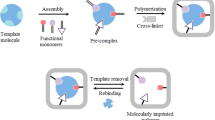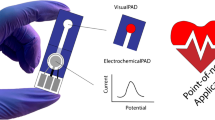Abstract
Aminoglycosides are widely used antibiotics that bind to the bacterial 30S ribosomal subunit to inhibit translation. Owing to their adverse side effects and narrow therapeutic index, monitoring blood levels of aminoglycosides is important to maximize their effectiveness and minimize their toxicity. Current monitoring techniques require a well-equipped diagnostic laboratory. The present study aimed to present a proof-of-concept for a simple, low-cost biochemical assay utilizing a paper platform for the detection of serum/whole blood aminoglycosides. A paper-based bioassay chip for the assay was developed by spotting and freeze-drying cell-free transcription/translation reaction machinery for a luminescent reporter protein (NanoLuc) within an array of wax circles printed on filter paper. The paper-based chip could be used to quantify serum/whole blood aminoglycosides within clinically relevant concentrations in 30–60 min by spotting minimal volumes of samples, followed by the NanoLuc substrate, in the wax circles and detecting the associated changes in luminescence signals, using a simple digital camera. Furthermore, a one-pot assay in which cell-free transcription/translation reaction machinery and NanoLuc substrate are mixed in advance and embedded in paper could be used to detect an aminoglycoside in serum. Overall, our paper-based bioassay can potentially provide a basic platform for the simple and low-cost therapeutic monitoring of aminoglycosides, especially in resource-limited regions.





Similar content being viewed by others
References
Avent, M. L., Rogers, B. A., Cheng, A. C., & Paterson, D. L. (2011). Current use of aminoglycosides: indications, pharmacokinetics and monitoring for toxicity. Internal Medicine Journal, 41(6), 441–449.
Xie, J., Talaska, A. E., & Schacht, J. (2011). New developments in aminoglycoside therapy and ototoxicity. Hearing Research, 281(1-2), 28–37.
McLawhon, R. W. (2012). Guidelines for the monitoring of vancomycin, aminoglycosides and certain antibiotics. In A. Dasgupta (Ed.), Therapeutic drug monitoring (pp. 197–218). San Diego: Academic Press.
Bambeke, F. V., Mingeot-Leclercq, M. P., Glupczynski, Y., & Tulkens, P. M. (2017). Mechanisms of action. In J. Cohen, W. G. Powderly, & S. M. Opal (Eds.), Infectious diseases (pp. 1162–1180). Amsterdam: Elsevier.
Roberts, J. A., Norris, R., Paterson, D. L., & Martin, J. H. (2012). Therapeutic drug monitoring of antimicrobials. British Journal of Clinical Pharmacology, 73(1), 27–36.
Leggett, J. E. (2017). Aminoglycosides. In J. Cohen, W. G. Powderly, & S. M. Opal (Eds.), Infectious diseases (Vol. 2, pp. 1233–1238). Amsterdam: Elsevier.
Roca, I., Akova, M., Baquero, F., Carlet, J., Cavaleri, M., Coenen, S., Cohen, J., Findlay, D., Gyssens, I., Heuer, O. E., Kahlmeter, G., Kruse, H., Laxminarayan, R., Liebana, E., Lopez-Cerero, L., MacGowan, A., Martins, M., Rodriguez-Bano, J., Rolain, J. M., Segovia, C., Sigauque, B., Tacconelli, E., Wellington, E., & Vila, J. (2015). The global threat of antimicrobial resistance: science for intervention. New Microbes and New Infections, 6, 22–29.
Farouk, F., Azzazy, H. M., & Niessen, W. M. (2015). Challenges in the determination of aminoglycoside antibiotics, a review. Analytica Chimica Acta, 890, 21–43.
Rowe, A. A., Miller, E. A., & Plaxco, K. W. (2010). Reagentless measurement of aminoglycoside antibiotics in blood serum via an electrochemical, ribonucleic acid aptamer-based biosensor. Analytical Chemistry, 82(17), 7090–7095.
Nwobodo, N. (2014). Therapeutic drug monitoring in a developing nation: a clinical guide. JRSM Open, 5, 2054270414531121.
Martinez, A. W., Phillips, S. T., Butte, M. J., & Whitesides, G. M. (2007). Patterned paper as a platform for inexpensive, low-volume, portable bioassays. Angewandte Chemie (International Ed. in English), 46(8), 1318–1320.
Liana, D. D., Raguse, B., Gooding, J. J., & Chow, E. (2012). Recent advances in paper-based sensors. Sensors (Basel), 12(9), 11505–11526.
Shah, P., Zhu, X., & Li, C. Z. (2013). Development of paper-based analytical kit for point-of-care testing. Expert Review of Molecular Diagnostics, 13(1), 83–91.
Martinez, A. W., Phillips, S. T., Whitesides, G. M., & Carrilho, E. (2010). Diagnostics for the developing world: microfluidic paper-based analytical devices. Analytical Chemistry, 82(1), 3–10.
Wu, G., & Zaman, M. H. (2012). Low-cost tools for diagnosing and monitoring HIV infection in low-resource settings. Bulletin of the World Health Organization, 90(12), 914–920.
Pardee, K., Green, A. A., Takahashi, M. K., Braff, D., Lambert, G., Lee, J. W., Ferrante, T., Ma, D., Donghia, N., Fan, M., Daringer, N. M., Bosch, I., Dudley, D. M., O'Connor, D. H., Gehrke, L., & Collins, J. J. (2016). Rapid, low-cost detection of Zika virus using programmable biomolecular components. Cell, 165(5), 1255–1266.
Pardee, K., Green, A. A., Ferrante, T., Cameron, D. E., DaleyKeyser, A., Yin, P., & Collins, J. J. (2014). Paper-based synthetic gene networks. Cell, 159(4), 940–954.
Duyen, T. T. M., Matsuura, H., Ujiie, K., Muraoka, M., Harada, K., & Hirata, K. (2017). Paper-based colorimetric biosensor for antibiotics inhibiting bacterial protein synthesis. Journal of Bioscience and Bioengineering, 123(1), 96–100.
Hosoda, K., Sunami, T., Kazuta, Y., Matsuura, T., Suzuki, H., & Yomo, T. (2008). Quantitative study of the structure of multilamellar giant liposomes as a container of protein synthesis reaction. Langmuir, 24(23), 13540–13548.
Carrilho, E., Martinez, A. W., & Whitesides, G. M. (2009). Understanding wax printing: a simple micropatterning process for paper-based microfluidics. Analytical Chemistry, 81(16), 7091–7095.
Griss, R., Schena, A., Reymond, L., Patiny, L., Werner, D., Tinberg, C. E., Baker, D., & Johnsson, K. (2014). Bioluminescent sensor proteins for point-of-care therapeutic drug monitoring. Nature Chemical Biology, 10(7), 598–603.
Shimizu, Y., Inoue, A., Tomari, Y., Suzuki, T., Yokogawa, T., Nishikawa, K., & Ueda, T. (2001). Cell-free translation reconstituted with purified components. Nature Biotechnology, 19(8), 751–755.
Hall, M. P., Unch, J., Binkowski, B. F., Valley, M. P., Butler, B. L., Wood, M. G., Otto, P., Zimmerman, K., Vidugiris, G., Machleidt, T., Robers, M. B., Benink, H. A., Eggers, C. T., Slater, M. R., Meisenheimer, P. L., Klaubert, D. H., Fan, F., Encell, L. P., & Wood, K. V. (2012). Engineered luciferase reporter from a deep sea shrimp utilizing a novel imidazopyrazinone substrate. ACS Chemical Biology, 7(11), 1848–1857.
McCoy, L. S., Xie, Y., & Tor, Y. (2011). Antibiotics that target protein synthesis. Wiley Interdisciplinary Reviews. RNA, 2(2), 209–232.
Zhang, D., & Liu, Q. (2016). Biosensors and bioelectronics on smartphone for portable biochemical detection. Biosensors & Bioelectronics, 75, 273–284.
Quesada-Gonzalez, D., & Merkoci, A. (2017). Mobile phone-based biosensing: an emerging "diagnostic and communication" technology. Biosensors & Bioelectronics, 92, 549–562.
Karig, D. K., Bessling, S., Thielen, P., Zhang, S., & Wolfe, J. (2017). Preservation of protein expression systems at elevated temperatures for portable therapeutic production. Journal of the Royal Society, Interface, 14(129), 20161039.
Acknowledgments
We thank the Biological Resource Center in the National Institute of Technology and Evaluation (NBRC, Japan) for providing E. coli phage T3. The study was supported by a grant from Long-range Research Initiative (LRI) by the Japan Chemical Industry Association (JCIA) (13_PT05-01) and in part by Kurita Water and Environment Foundation, Japan.
Author information
Authors and Affiliations
Corresponding author
Ethics declarations
Conflict of Interest
There are no conflicts of interest to declare.
Additional information
Publisher’s Note
Springer Nature remains neutral with regard to jurisdictional claims in published maps and institutional affiliations.
Electronic Supplementary Material
ESM 1
(DOCX 110 kb)
Rights and permissions
About this article
Cite this article
Matsuura, H., Ujiie, K., Duyen, T.T.M. et al. Development of a Paper-Based Luminescence Bioassay for Therapeutic Monitoring of Aminoglycosides: a Proof-of-Concept Study. Appl Biochem Biotechnol 189, 798–809 (2019). https://doi.org/10.1007/s12010-019-03048-4
Received:
Accepted:
Published:
Issue Date:
DOI: https://doi.org/10.1007/s12010-019-03048-4




